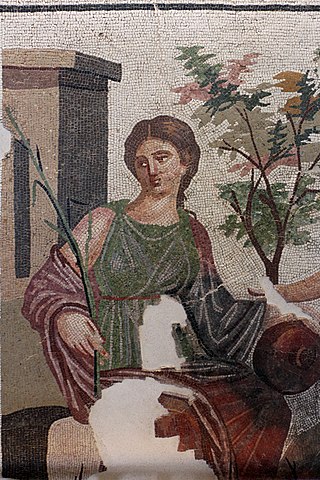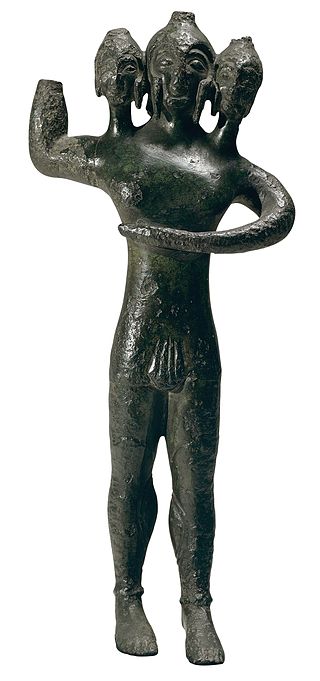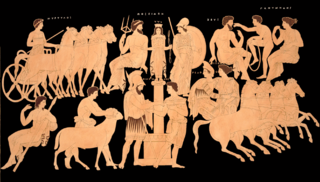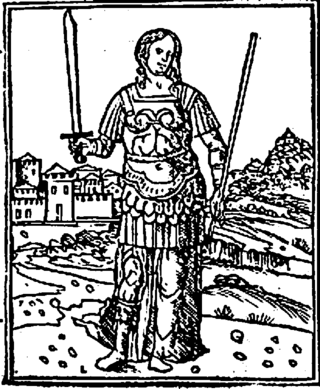
The Hanging Gardens of Babylon were one of the Seven Wonders of the Ancient World listed by Hellenic culture. They were described as a remarkable feat of engineering with an ascending series of tiered gardens containing a wide variety of trees, shrubs, and vines, resembling a large green mountain constructed of mud bricks. It was said to have been built in the ancient city of Babylon, near present-day Hillah, Babil province, in Iraq. The Hanging Gardens' name is derived from the Greek word κρεμαστός, which has a broader meaning than the modern English word "hanging" and refers to trees being planted on a raised structure such as a terrace.

In Greek mythology, Hippolyta, or Hippolyte, was a daughter of Ares and Otrera, queen of the Amazons, and a sister of Antiope and Melanippe. She wore her father Ares' zoster, the Greek word found in the Iliad and elsewhere meaning "war belt". Some English translations prefer "girdle". Hippolyta figures prominently in the myths of both Heracles and Theseus. The myths about her are so varied it is thought that they may be about different women. The name Hippolyta translates as "she who unleashes the horses", deriving from two Greek roots meaning "horse" and "let loose".

In Greek mythology, Erato is one of the Greek Muses, the inspirational goddesses of literature, science, and the arts. The name would mean "desired" or "lovely", if derived from the same root as Eros, as Apollonius of Rhodes playfully suggested in the invocation to Erato that begins Book III of his Argonautica.

Cyrene (Latin) or Kyrene, pronounced variously as sy-REE-nee or ky-REE-nee, was a figure in Greek mythology considered the etymon of the Greek colony of Cyrene in eastern Libya in North Africa. She was said to have been a Thessalian princess who became the queen of Cyrene, founded and named in her honor by Apollo. The story is entirely apocryphal, the city having been founded by settlers from Thera.

In Greek mythology, Aeson was a king of Iolcus in Thessaly. He was the father of the hero Jason. According to one version of the story, he was imprisoned by his half-brother Pelias, and when Pelias intended to kill him he committed suicide. In another story, he was killed by Jason's wife Medea, who brought him back to life as a young man.

In Greek mythology, Geryon, son of Chrysaor and Callirrhoe, the grandson of Medusa and the nephew of Pegasus, was a fearsome giant who dwelt on the island Erytheia of the mythic Hesperides in the far west of the Mediterranean. A more literal-minded later generation of Greeks associated the region with Tartessos in southern Iberia. Geryon was often described as a monster with either three bodies and three heads, or three heads and one body, or three bodies and one head. He is commonly accepted as being mostly humanoid, with some distinguishing features and in mythology, famed for his cattle.

In Greek mythology, King Oenomaus of Pisa, was the father of Hippodamia and the son of Ares. His name Oinomaos denotes a wine man.
In Greek mythology, Zeuxippe was the name of several women. The name means "she who yokes horses," from zeugos, "yoke of beasts" / "pair of horses," and hippos, "horse."

The Mares of Diomedes, also called the Mares of Thrace, were a herd of man-eating horses in Greek mythology. Magnificent, wild, and uncontrollable, they belonged to Diomedes of Thrace, king of Thrace, son of Ares and Cyrene who lived on the shores of the Black Sea. Bucephalus, Alexander the Great's horse, was said to be descended from these mares

Diodorus Siculus or Diodorus of Sicily was an ancient Greek historian. He is known for writing the monumental universal history Bibliotheca historica, in forty books, fifteen of which survive intact, between 60 and 30 BC. The history is arranged in three parts. The first covers mythic history up to the destruction of Troy, arranged geographically, describing regions around the world from Egypt, India and Arabia to Europe. The second covers the time from the Trojan War to the death of Alexander the Great. The third covers the period to about 60 BC. Bibliotheca, meaning 'library', acknowledges that he was drawing on the work of many other authors.

Semiramis was the legendary Lydian-Babylonian wife of Onnes and of Ninus, who succeeded the latter on the throne of Assyria, according to Movses Khorenatsi. Legends narrated by Diodorus Siculus, who drew primarily from the works of Ctesias of Cnidus, describe her and her relationships to Onnes and King Ninus.

Lamia, in ancient Greek mythology, was a child-eating monster and, in later tradition, was regarded as a type of night-haunting spirit (daemon).

In Greek mythology, Sinope was one of the daughters of Asopus and thought to be an eponym of the city Sinope on the Black Sea.
In Greek mythology, Belus was a king of Egypt and father of Aegyptus and Danaus and (usually) brother to Agenor. The wife of Belus has been named as Achiroe, or Side.

Gangaridai is a term used by the ancient Greco-Roman writers to describe people or a geographical region of the ancient Indian subcontinent. Some of these writers state that Alexander the Great withdrew from the Indian subcontinent because of the strong war elephant force of the Gangaridai.

In Greek mythology and religion, Corcyra or Korkyra is the naiad daughter of the river-god Asopos and the nymph Metope, herself the daughter of the river-god Ladon. She is the personification and tutelary goddess of the ancient Greek city and island of Korkyra, now better known as Corfu.
Stilbe in Greek mythology may refer to the following personages:

Bibliotheca historica is a work of universal history by Diodorus Siculus. It consisted of forty books, which were divided into three sections. The first six books are geographical in theme, and describe the history and culture of Egypt, of Mesopotamia, India, Scythia, and Arabia (II), of North Africa (III), and of Greece and Europe (IV–VI). In the next section, he recounts human history starting with the Trojan War, down to the death of Alexander the Great. The last section concern the historical events from the successors of Alexander down to either 60 BC or the beginning of Caesar's Gallic War in 59 BC. He selected the name "Bibliotheca" in acknowledgement that he was assembling a composite work from many sources. Of the authors he drew from, some who have been identified include: Hecataeus of Abdera, Ctesias of Cnidus, Ephorus, Theopompus, Hieronymus of Cardia, Duris of Samos, Diyllus, Philistus, Timaeus, Polybius and Posidonius.

In Greek mythology, Glaucus was a Greek prophetic sea-god, born mortal and turned immortal upon eating a magical herb. It was believed that he came to the rescue of sailors and fishermen in storms, having earlier earned a living from the sea himself.
In Greek mythology, Nireus was a king of the island Syme and one of the Achaean leaders in the Trojan War. He was renowned for his outstanding beauty, being described as the second most handsome man in the Greek camp after Achilles.

















